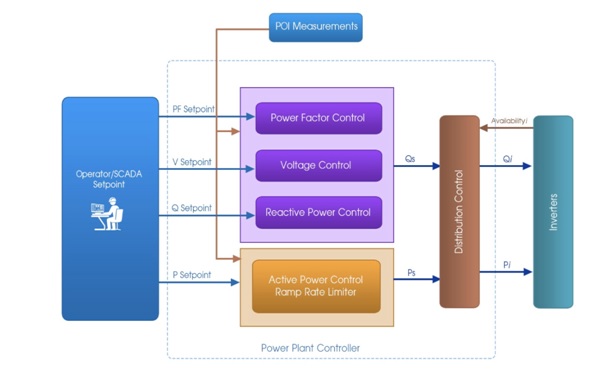Pacemaker Energy Supply Power Plant Controller
Key Functions and Benefits
The Pacemaker Energy Supply Power Plant Controller (PPC) plays a critical role in ensuring the efficient and stable operation of solar power plants. Its key functions include:
- Active Power Control : Manages the plants overall power output, ensuring it aligns with grid demands or curtailment requirements.
- Ramp Rate Control : Prevents sudden changes in power output, safeguarding grid stability.
- Reactive Power Control : Optimizes the power factor, reducing energy losses and improving grid efficiency.
- Power Factor Control : Maintains a specific power factor, complying with grid regulations and enhancing system performance.
- Grid Support Control : Assists in grid stabilization by responding to frequency fluctuations and voltage variations.

The PPC employs a closed-loop control system, meaning it continuously monitors the plant's performance and adjusts its output accordingly. It communicates with inverters using industry-standard protocols, enabling precise and rapid control. In essence, the PPC acts as the central nervous system of the solar power plant, ensuring its seamless integration into the grid.
While the PPC offers a solid foundation for solar power plant control, there are areas for potential improvement and consideration:
- Advanced Analytics : Incorporating advanced analytics can provide insights into plant performance, optimize maintenance schedules, and identify potential issues early on.
- Predictive Control : Utilizing predictive models can enable the PPC to anticipate future grid conditions and adjust plant operations accordingly, improving efficiency and reliability.
- Integration with Energy Storage : Integrating with energy storage systems can enhance grid stability, reduce peak loads, and optimize energy usage.
- Cybersecurity : Given the critical role of the PPC, robust cybersecurity measures are essential to protect against cyber threats.
By addressing these areas, the Pacemaker Energy Supply Power Plant Controller can continue to evolve and provide even more effective and efficient control of solar power plants.
In a solar park, the Master Power Plant Controller (PPC) and Slave PPC play crucial roles in managing and optimizing the operation of the entire solar power system. Here's a breakdown of their functions:
- Primary Role : The Master PPC oversees and manages the overall operation of the solar park. It acts as the central control unit that coordinates all the activities of the solar power plant.
- Functions :
- Centralized Monitoring : Collects data from all Slave PPCs and other components in the solar park to monitor performance, status, and health of the system.
- Optimization :Implements strategies for optimizing power generation, including adjusting setpoints, managing power flow, and balancing loads.
- Communication : Interfaces with external systems such as the grid operator, weather stations, and other relevant entities to ensure smooth operation and compliance with regulations.
- Control : Can make real-time adjustments to ensure the solar park operates efficiently and safely.
- Data Aggregation : Aggregates data from various sources to generate reports, forecasts, and analyses for performance and maintenance.
- Primary Role : The Slave PPCs operate at a more localized level within the solar park, managing specific sections or components of the park.
- Functions :
- Local Control : Manages and controls the operation of individual solar inverters, strings, or sections of the solar array.
- Data Collection :Gathers performance data from the components it controls and reports this data to the Master PPC.
- Real-Time Adjustments : Implements control commands received from the Master PPC to adjust settings and optimize performance at a local level.
- Fault Detection : Monitors local components for faults or issues and reports them to the Master PPC for further action.
- Coordination : The Master PPC coordinates with Slave PPCs to ensure that all parts of the solar park work together harmoniously.
- Hierarchical Control : The Master PPC provides high-level control and strategic management, while Slave PPCs handle the operational details of specific sections or components.
- Data Flow : Slave PPCs send data and status updates to the Master PPC, which aggregates this information and uses it to make overarching decisions and optimizations.
Overall, this hierarchical approach ensures efficient and reliable operation of the solar park, maximizing energy production and maintaining system stability.
Would you like to discuss any of these points in more detail, or do you have other questions about the PPC or solar power plant control?


